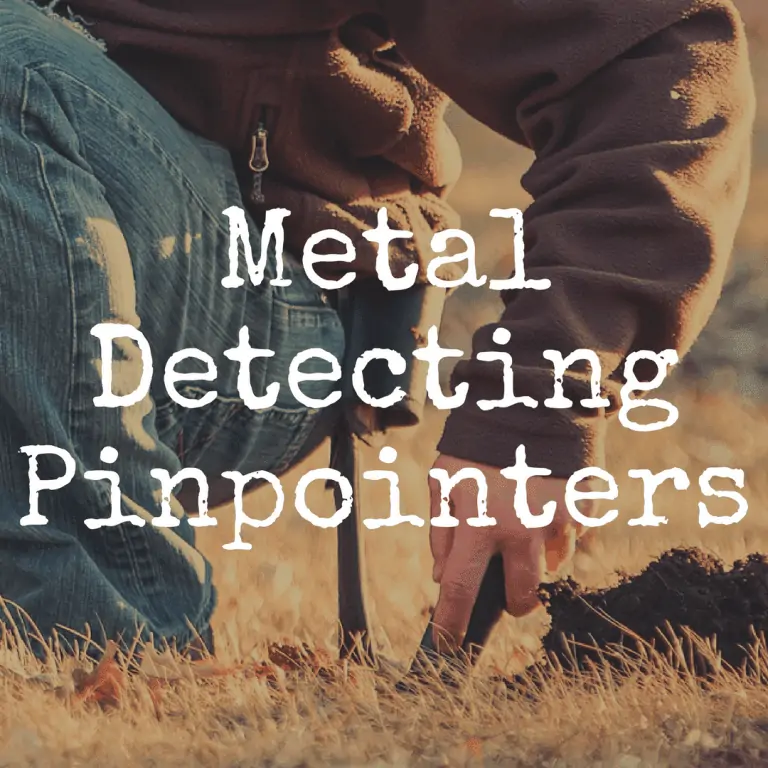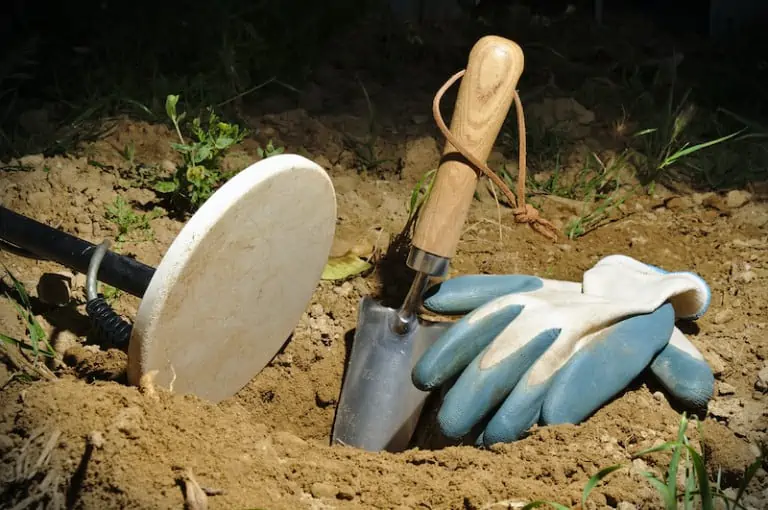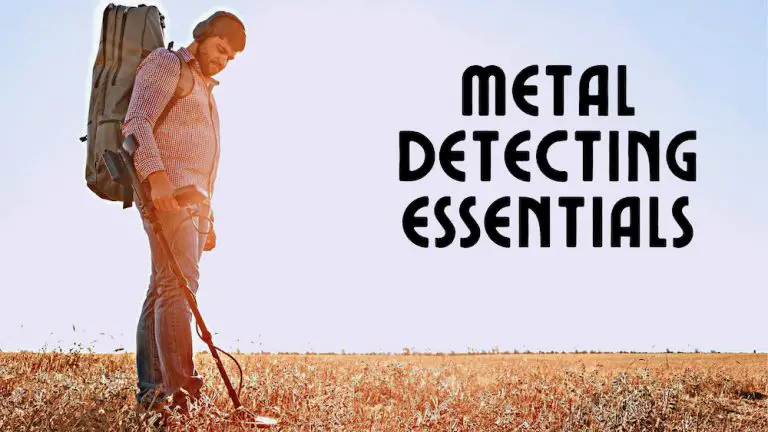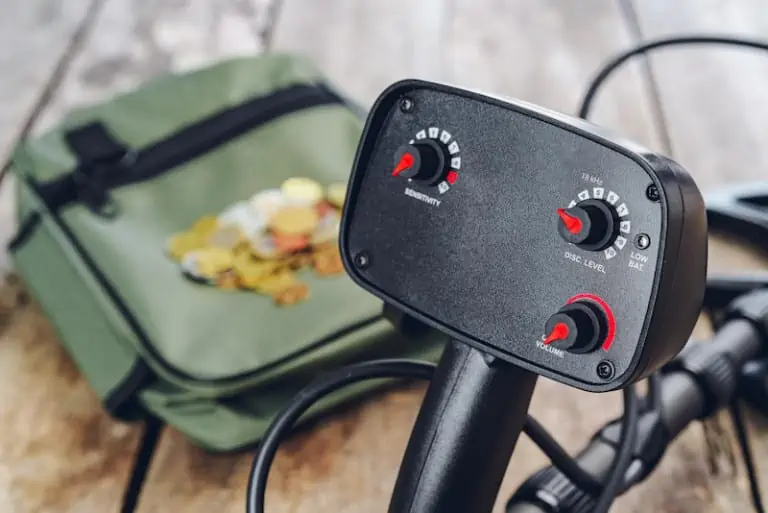Guide to Metal Detecting Shovels and Scoops
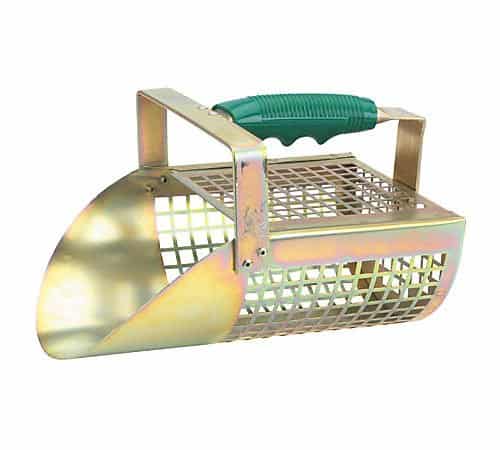
You’ve got your metal detector, treasure pouch, and a garden trowel you bought for $1 at the local hardware or gardening store. You’re all set to hit your first field and find riches beyond your wildest dreams, right?
Wrong.
You can give it your best effort, but that gardening trowel is going to break within the first hour of heavy digging. You’ll be lucky if it lasts that long.
How do I know? I was once like you, grasshopper. Only I didn’t have this article in front of me to show me the light. I kept snapping trowel after trowel wondering how people ever managed to actually dig deep enough to find anything of note.
It took me an embarrassing amount of time to realize that I needed to buy proper metal detector digging tools. At that point, I hadn’t yet joined a metal detecting club and I didn’t know any other detectorists to ask for advice.
I educated myself on shovels and scoops by reading numerous online articles and hundreds of product reviews for the digging instruments I was interested in. Lucky for you, you have me. I’ve done all the research for you.
Below, please take a look at the interactive table to get a glimpse of some of the metal detecting scoops and shovels we will be discussing in today’s article:
| Model | Photo | Price |
|---|---|---|
 | Garrett Metal Sand Scoop | $ |
 | Garrett Edge Digger | $ |
 | Fiskars Big Grip Garden Knife | $ |
And now, without further ado, here’s what you’ll want to consider when buying shovels and scoops.
Price
I’m not going to lie. The first time I bought a real digging implement, I swallowed hard as I made the purchase. It seemed a bit extravagant. You think that buying your metal detector will be the bulk of the money you need to pay, and it is. But quality shovels and scoops aren’t cheap. It’s hard to justify spending that kind of money on a hand-held digging instrument when you see advertisements for gardening trowels for $1.
I held out for about a year before I bought my first Fiskars. Once I had that digging knife in my hand, metal detecting became a whole new world. I unearthed more targets than ever before because it literally only took seconds to dig a plug.
Durability and function
With shovels and scoops you get what you pay for. If you buy something cheap, be prepared for it to break quickly. Cheaper options won’t have the sharp serrated edges that help cut a clean plug.
If you’re new to detecting, cutting a clean plug is essential because no one will be able to tell where you’ve been. You’ll be like a metal detecting ninja. That’s important if you ever want to be allowed to hunt on someone’s property again. If you leave a yard looking like the gopher from “Caddyshack” lives there, you won’t be invited back. Plus, you’ll ruin it for the rest of us. That person will be soured on detectorists in general, and they may tell their friends about their bad experience.
Negative word of mouth will eventually translate into less places for all of us to dig.
Location
When you are metal detecting, you’ll often be digging through untilled ground, gravel, and rocks. You need digging tools that can hold up, use after use. But you also need to be mindful of the other people who use that land. If you are in a park, for instance, you’ll get some major stink eye from the people out there who hate metal detecting if you whip out a full-size shovel.
Whether it’s warranted or not, some people are worried about detectorists tearing up the ground. Even if you cut a careful grass plug with that full-size shovel, people won’t be happy. Even seeing a full-size shovel there annoys them. In parks or other public places, the best thing to dig with is an unobtrusive, small trowel or digging knife – something that’s a little less obvious than a shovel.
Sand
There’s nothing worse than hunting through sand with a garden knife or trowel. To me, it feels like what sinking in quicksand must feel like. The more frantically you dig at the sand, the more futile your efforts are. The hole keeps filling in with the surrounding sand and the item you are trying to grab keeps getting pushed further and further away from your eager little hands.
Length
Metal detecting can be back-breaking work. If you have problems squatting, bending over, or sitting on your knees for any length of time, you’ll want to find a comfortable shovel you can reliably use instead of a trowel or spade whenever possible. That extra length you’ll find on a shovel will spare your back hours of agony.
And now, without further ado, here are ten digging tools you should strongly consider acquiring for your metal detecting hunts.
The Top 10 digging tools
Here are some of our favorite digging tools and accessories that really help out when you’re metal detecting.

Fiskars Big Grip Garden Knife:
This is my favorite digging tool of all time. This knife is a bargain at $8. I would gladly pay $30 for this product, but please don’t tell the company that. I have used my Fiskars on every single hunt other than beach hunts for the past three or four years. These things are tough as nails, and I think they hold up just as well as the pricier options out there.
Despite digging through gravel, rocks and tree roots, my Fiskars haven’t bent a bit. They feel substantial in my hand, but not too weighty. Even though I am shamefully weak in the arms – I have the upper body strength of a T-Rex – I can slice through the ground easily with my Fiskars.

Garrett Metal Sand Scoop:
No trip to the beach would be complete without the Garrett Metal Sand Scoop, which retails for about $40. I’m going to let that sink in for a second. Yes, I know spending $40 on a scoop may seem excessive, especially if you don’t do much beach hunting, but, believe me, it’s worth it.
With the Garrett Metal Sand Scoop, you simply scoop up some sand, watch the sand filter out through the ingenious little holes on the scoop, and wait for the metal to become trapped in the scoop. This scoop could very well pay for itself on your first beach hunt.
Lesche Digging Tool and Sod Cutter:
You’ll have to dig up a lot of coins to pay for this one, but it will be worth it. Metal detectorists swear by this tool, but it will cost you about $40. It has a 7-inch blade, with a width of 1 and ¾ inches. It comes with a serrated edge which can, with a little bit of muscle on your part, cut right through smaller tree roots.
That’s great news since you can find many targets near big, old trees that people may have used for shade decades ago. But digging by those trees can be a problem since you’ll encounter so many roots along the way. With this bad boy on your belt, those roots will not be an obstacle.

Garrett Edge Digger:
This tool has a carbon steel blade and it can take a serious beating. Again, you’ll be looking at a cost in the range of $40. It has a comfy rubber handle. But here’s my one beef with this tool – if you plan on digging roots, go with the Lesche instead since it costs about the same. The teeth on the Lesche seem sharper, which makes root digging easier. I feel like you get more power with the Lesche compared to the Garrett Edge Digger.
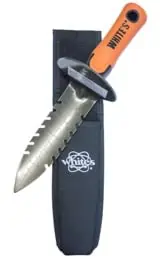
White’s DigMaster:
The engraved ruler measurements on this tool will help you gauge exactly how deep you had to go to reach a coin or ring – that will help avoid the exaggerated tales of depth that all detectorists hear at some point. This tool is also around $40 and will help you cut a nice plug.
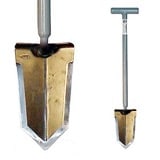
Lesche Sampson Pro-Series shovel with T-handle:
Lesche is known for its quality digging tools. It has that reputation because of products like this. At $60, you can expect years of use from this metal detector shovel. It is 31 inches long, with blade dimensions of 4 inches wide and 7 and ½ inches long. You can pry away some tough rocks with this at your side.
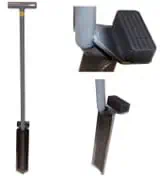
40-inch Ground Shark shovel:
This shovel slices right into the ground with very little effort, which means a lot less grumbling, grunting, and heavy breathing for you. A pricy option at $75, this unit excels at making small, precise holes. When you’ve grabbed your treasure, you take the grass and dirt plug, place it back in the hole, and no one will ever know you were there. Just be aware in case you are vertically challenged, some people who use it aren’t crazy about the length – they think it is a bit too long.

Fiskars 46-inch steel D-handle shovel:
At 5 pounds, this shovel is fairly lightweight to carry around – but it’s no lightweight when it comes to digging. It has an oversized step on it which makes it more comfortable when you’re putting your weight onto the shovel to dig into the ground. It’s not the absolute best shovel on this list, but at $25, it’s a great choice for people who are watching their money.
Lesche Ground Shark Relic Hunter shovel:
It’s almost impossible to go wrong with a Lesche shovel or trowel in my opinion. When you get a Lesche, you know you are getting high quality. This shovel can handle heavy clay soil, and it can be purchased for just over $70.
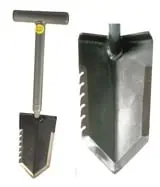
Lesche Mini Sampson 18-inch T-handle shovel:
This shovel is good for those who want the power of a full-sized shovel, but don’t want to carry one around. A happy medium between a trowel and a full-sized shovel, this tool costs approximately $70. Don’t let its size fool you. With its serrated edges, this can cut into some seriously hard ground. Taller detectorists might find this shovel a bit on the short side though.
- If you liked this article, please “like” our new Discover Detecting Facebook page.
